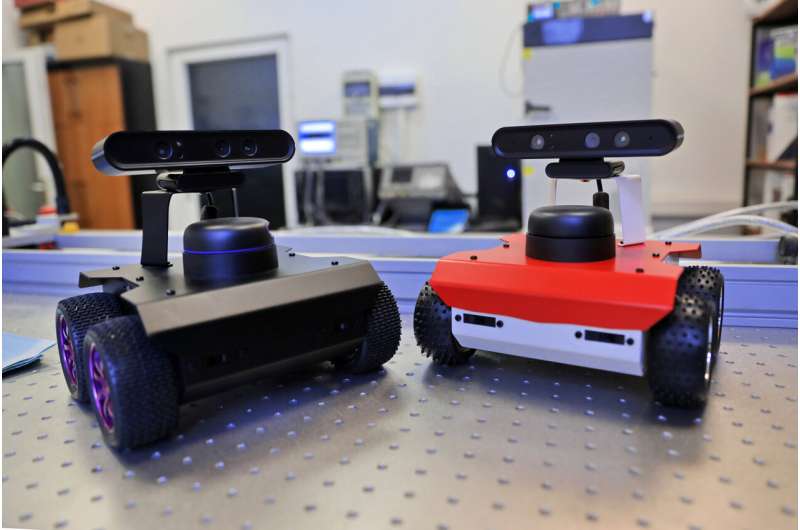Husarion ROSbot 2.0 PRO and Husarion ROSbot 2.0. Credit: Andrzej Romański
Researchers from the Institute of Engineering and Technology at the Nicolaus Copernicus University have developed an algorithm that will allow mobile robots to escape blind alleys and avoid obstacles.
Why do we not enter blind alleyways when walking in the city? Thanks to our perception (seeing appropriate signs and assessing distances) we are able to predict that there is an obstacle in front of us—we do not have to check it at all while walking to the end of the street. We are able to move onto the right track at the right moment, without having to waste time turning back.
"This is exactly the behavior we based on when developing the path planning algorithm that allows mobile robots to avoid dead ends" explains Tomasz Tarczewski, NCU Prof. from the Institute of Engineering and Technology.
His team received a grant for their research in the INCOOP competition as part of the Excellence Initiative—Research University. The results have been published in the journal Energies.
Why did they take an interest and decide to solve this particular problem?
"Nowadays mobile robots are becoming more and more common in warehouses and production halls. Despite special routes, master algorithms coordinating the work of many robots in one hall, sometimes the path of a robot will be blocked. Their main problem is that they often run into so-called dead ends," says Prof. Tarczewski, "and yet a collision-free passage is essential for the safety of the production cycle."
One way to solve this problem is to implement local path planning algorithms to ease the avoidance of various types of obstacles. Thanks to these algorithms, it is possible for the robot to autonomously unblock itself and continue its route.
"The principle of operation of most of these mechanisms involves the introduction of an additional algorithm leading the robot out of a dead end. In such an approach, the distance traveled by the mobile robot increases due to the necessity of retreating and causes unnecessary power consumption," explains Rafal Szczepanski. "For this purpose, we have applied a LiDAR sensor, i.e., a laser scanner providing information on distances from obstacles around the robot."
Then, based on the readings, the team of researchers at the Institute of Engineering and Technology developed a dead-end prediction mechanism: the robot compares real-time information about the available space with its own dimensions and makes a decision about passability based on that information. In order for the robot to give up exploring the impassable section, it must be provided with a mechanism to bypass it.
For this task, the researchers used augmented reality technology.
"In very general terms, it is the creation of additional virtual objects and adding them to reality. This technology is commonly used in various applications on smartphones, tablets, such as mobile games, photo and video apps and educational toys," says Artur Bereit.
Precisely how do you program the dead-end entry blocking mechanism into the robot?
"Its reality should be extended with a virtual wall that will prevent it from passing. When a dead end is detected, a virtual wall is created as well as an additional obstacle on the left or right side of the robot in order to guide it in the right direction," explains Rafal Szczepanski. "It is this innovative and interdisciplinary combination of mobile robotics and augmented reality technology that allowed us to publish the results of our research."
"The team of researchers from our university implemented the developed algorithm of the potential fields method supported by augmented reality technology in the mobile robot Husarion ROSbot 2.0 PRO and conducted a series of laboratory tests to demonstrate the effectiveness of the proposed solution. The results are very promising—the researchers demonstrated a significant improvement in the properties of the potential fields algorithm commonly used in mobile robotics."
More information: Rafal Szczepanski et al, Efficient Local Path Planning Algorithm Using Artificial Potential Field Supported by Augmented Reality, Energies (2021). DOI: 10.3390/en14206642
Provided by Nicolaus Copernicus University in Torun
























